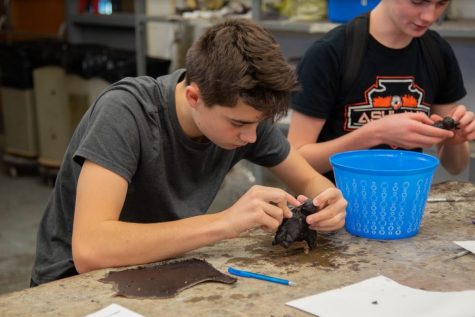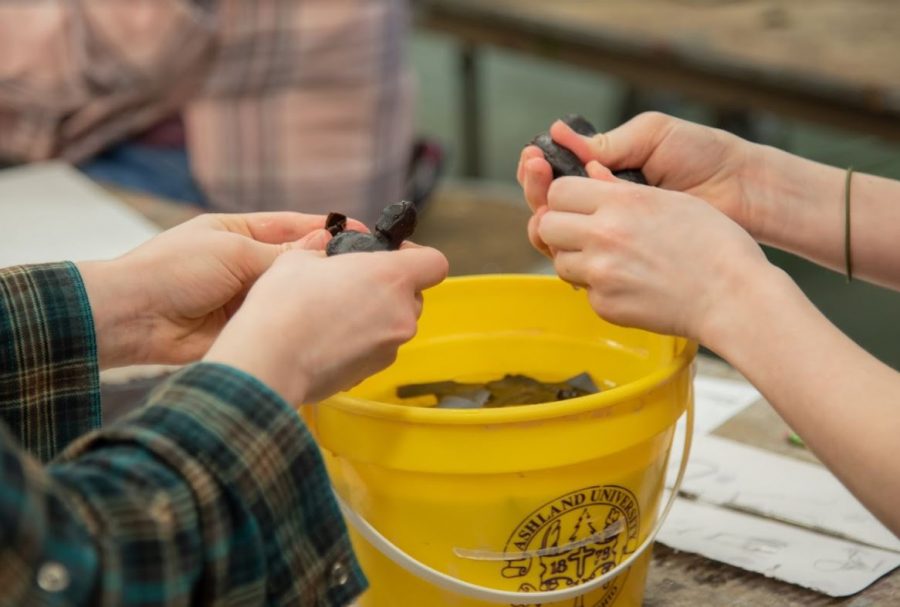High School Art Experience welcomes area students
March 3, 2020

The Ashland University Art and Design department opened its doors to area high school students Feb. 29 for the 2020 High School Art Experience, allowing students to experience a smaller version of the program in person for the day.
Professor Dan McDonald, chair of the art and design department, said the event started around seven or eight years ago as a way for the department to promote themselves to high schools around the state, as initially the program was mostly unknown outside the area.
“We realized that most people that we would speak to outside of Ashland did not know that Ashland had an art program, so we figured we have a lot of art education graduates that we could talk with and we could try to just contact any of the high schools,” McDonald said. “I sat down with my faculty, we talked about what we thought would be a good thing and we gave it a go.”
Within the event itself, there are six different sessions participants can pick from: sculpture, drawing and printmaking offered in the morning and ceramics, digital art and painting offered in the afternoon.
This year McDonald said that he decided to change the event from allowing students to “pick two courses and a potential third” to being able to choose from one of the three morning courses and one of the three afternoon courses due to the growing popularity of the event and courses getting too full.
In the first few years, McDonald said that the event attracted around 12 to 15 participants but has since grown to around 30 to 50 participants each year after from all around Ohio, including “as far as Youngstown and Dayton.” This year they were expecting 36 participants and had 30 show, which McDonald said was “perfect” as each class in the morning and afternoon had around 10 students.
Although it started as somewhat of a recruiting tool, McDonald assures that he does not want it to “feel like a recruiting event” and wants students to enjoy themselves and interact with other students who enjoy art as well.
Despite the experience being a little different each year, McDonald also said he really enjoys getting to see students try new things and enjoy themselves, recalling a moment from last year’s event where his own son, “who normally wants nothing to do with art,” participated and made a sculpture and “still has it in his room.”
Priscilla Roggenkamp, associate professor of art at AU, teaches the figure drawing course and said that she really enjoys getting to walk through what college is like with these high school students who have “varying skills” to help them better envision themselves in a college art classroom and overall “get to know them better.”
“I think when you’re in high school it’s hard to envision what college is like and if you’ll fit in and so this is our gift to those who are aspirational in terms of going to college to see themselves, to realize that they can fit in and they can bring their skill set and that it might not be the same as someone else’s and they can still be okay there,” Roggenkamp said. “I enjoy seeing their work and just thinking about them seeing themselves as college material in that way.”
McDonald said that when it comes to planning the event, he and the other faculty start the August prior to the event by picking a graduate of the program to design a poster for the department, as well as preparing a budget for the event, picking a date for the event to be held and sending out the poster to high schools around November or December for the February event.
After that, McDonald said they then get into the logistical organization of the event, such as “when the courses are going to be, if there is going to be a model for the drawing and painting classes,” in addition to determining how many people are going to show up and planning scaled-down versions of real projects his college classes are currently doing in the timeframe allotted for the courses that day.
“What we try to do is come up with a project that they probably would not do in their high school, so I have taught welding in a two and a half hour span where people learn how to weld and then we would weld something together as a group. I have done casting where they are working with modeling waxes and create structures that can be encapsulated, cooked out, and then pour metal in certain stages,” McDonald said. “One of the things that never happens in the high schools is actual figure drawing or figure sculpting, it might be figurative stuff like cartoons but not real people.”
Roggenkamp said that her part in the planning process involves getting a model for the figure drawing course, preparing classrooms, and then thinking and deciding on how she is going to engage the students in the event in the best way possible. She also said that she will have a few current AU students work with her, so she will need to teach them to best work with the “young artists as well.”
In an email interview after this year’s event, McDonald and Roggenkamp both had positive comments about this year’s event and the students who participated.
“Students were on the ball from the get-go. Some years it feels like there are always a few attendees who aren’t sure why they are there. This year each student seemed interested, eager, and willing to work,” McDonald said.
Roggenkamp also commented that the students “seemed to be having fun” and were “gaining new artistic experiences at the same time.”
“The students I had were focused on their experience, drawing from a live model. They took it seriously and the time flew. Mostly, they said they were surprised at how good their drawings were. With a focused time and place, no phones, and no distractions, they could see what was possible inside themselves,” Roggenkamp said.
This year Roggenkamp and McDonald said the Art Experience also introduced several new additions to the event, including student volunteers with the event now happening during the school year as opposed to past year’s events happening in May and a group discussion which allowed students to give feedback about the day.
“For the first time since holding this event, we scheduled in a group discussion for the end of the day. Students were asked to give suggestions and point out positives. Though most were a bit hesitant to speak up, those that did were really surprised at how much they learned in such a short period of time. There were several comments about the newness of drawing, painting, and sculpting the human figure,” McDonald said. “I was pleased with how at ease most of the students seemed, and how open they were to discussions and conversations with other students and with the faculty. I think it was a plus to have current AU students and alums there to help out as well.”
For those interested in the Art and Design department or attending next year’s event, they can contact Professor Dan McDonald at 419-289-5130, [email protected] or visit www.ashland.edu/cas/departments/art-design-department for more information.


